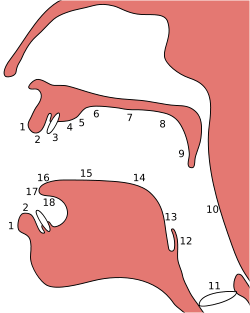Epiglottal stop
The epiglottal or pharyngeal stop is a type of consonantal sound, used in some spoken languages. The symbol in the International Phonetic Alphabet that represents this sound is ⟨ʡ⟩.
| Epiglottal stop (pharyngeal stop) | |||
|---|---|---|---|
| ʡ | |||
| IPA Number | 173 | ||
| Encoding | |||
| Entity (decimal) | ʡ | ||
| Unicode (hex) | U+02A1 | ||
| X-SAMPA | >\ | ||
| Braille | |||
| |||
| Audio sample | |||
|
source · help | |||
Epiglottal and pharyngeal consonants occur at the same place of articulation. Esling (2010) describes the sound covered by the term "epiglottal plosive" as an "active closure by the aryepiglottic pharyngeal stricture mechanism" – that is, a stop produced by the aryepiglottic folds within the pharynx.[1]
Features

The epiglottis is labelled as "12" in this diagram.
Features of the epiglottal stop:
- Its manner of articulation is occlusive, which means it is produced by obstructing airflow in the vocal tract. Since the consonant is also oral, with no nasal outlet, the airflow is blocked entirely, and the consonant is a stop.
- Its place of articulation is epiglottal, which means it is articulated with the aryepiglottic folds against the epiglottis.
- It has no defined phonation, although it is typically voiceless, which means it is produced without vibrations of the vocal cords. Voiced epiglottal "stops" tend toward being epiglottal flaps.
- It is an oral consonant, which means air is allowed to escape through the mouth only.
- It is a central consonant, which means it is produced by directing the airstream along the center of the tongue, rather than to the sides.
- The airstream mechanism is pulmonic, which means it is articulated by pushing air solely with the lungs and diaphragm, as in most sounds.
Occurrence
| Language | Word | IPA | Meaning | Notes | |
|---|---|---|---|---|---|
| Alyutor | [ʡujamtawilʔ] | 'people' | |||
| Amis | [ʡuʡuɺ̠ᵊ] | 'fog' | May have a trilled release, [ʡʢ]. | ||
| Archi | гӀарз | [ʡarz] | 'complaint' | ||
| Dahalo[2] | [ndoːʡo] | 'floor' | |||
| Haida | Northern dialects | g̱antl | [ʡʌntɬ] | 'water' | Corresponds to /q/ in southern dialects. |
| Jah Hut | [ɲɔˑhɔˑʡ] | 'tree' | |||
gollark: While I cannot grant you access to the actual notes cuboid it is stored on, I may be able to flood the chat with copy pasted things from it.
gollark: .
gollark: Interesting
gollark: It is securely stored on our utterly impenetrable servers.
gollark: How do you intend to see it, exactly?
See also
Notes
- John Esling (2010) "Phonetic Notation", in Hardcastle, Laver & Gibbon (eds) The Handbook of Phonetic Sciences, 2nd ed., p 695.
- Maddieson et al. (1993:27, 30, 33)
References
- Maddieson, Ian; Spajić, Siniša; Sands, Bonny; Ladefoged, Peter (1993), "Phonetic structures of Dahalo", in Maddieson, Ian (ed.), UCLA working papers in phonetics: Fieldwork studies of targeted languages, 84, Los Angeles: The UCLA Phonetics Laboratory Group, pp. 25–65
External links
- List of languages with [ʡ] on PHOIBLE
This article is issued from Wikipedia. The text is licensed under Creative Commons - Attribution - Sharealike. Additional terms may apply for the media files.
.svg.png)